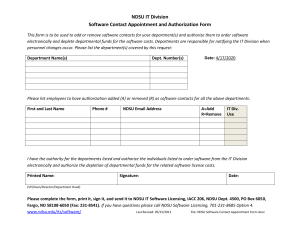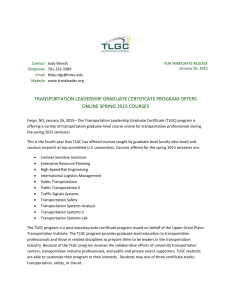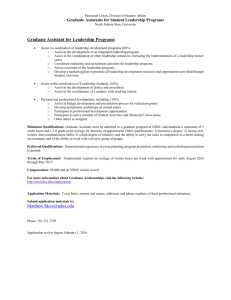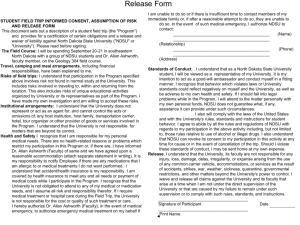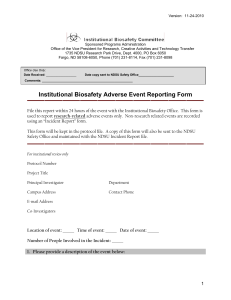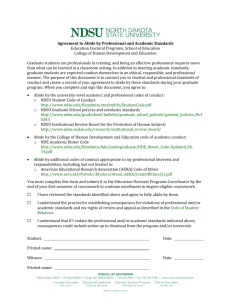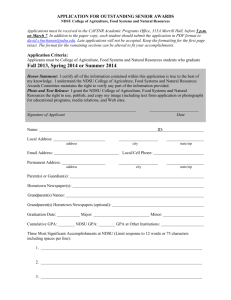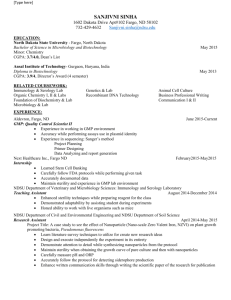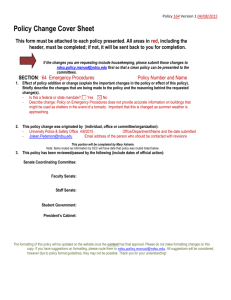NDSU Agriculture
advertisement
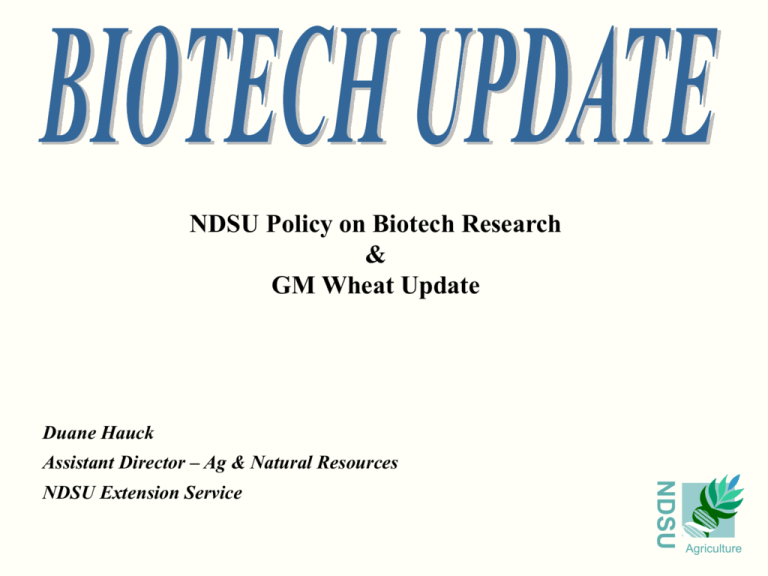
NDSU Policy on Biotech Research & GM Wheat Update Duane Hauck Assistant Director – Ag & Natural Resources NDSU NDSU Extension Service Agriculture NDSU Policy on Biotech Research Purpose of NDAES: “to develop and disseminate technology important to the production and utilization of food, feed, and fuel from crop and livestock enterprises” NDSU Agriculture NDSU Policy on Biotech Research • Indicates controlling authorities • Guide NDSU scientists • Communicate to the public NDSU Agriculture Key points of NDSU Policy on Biotech Research NDAES will… Continue to pursue new technologies for enhancing farming, food quality and the environment. NDSU Agriculture NDAES will… Promote the co-existence of various production and marketing systems. NDSU Agriculture NDAES will… Continue to develop genetically improved and environmentally adapted crops. NDSU Agriculture NDAES will… Manage development and propagation of new varieties to insure the availability of pure seed to the fullest extent possible. NDSU Agriculture NDAES will… Follow research protocols that exceed APHIS standards when testing regulated biotech crops. NDSU Agriculture Decision Making Process • The NDSU Institutional Biosafety Committee will give additional oversight to the approval process for testing regulated biotech material. • All regulated biotech research pre-approved by the NDAES Director. • All non-regulated biotech research communicated to the Director prior to planting. NDSU • Policy regarding biotech research at all NDAE locations set by the NDAES Director. Agriculture NDAES will… Continue to utilize public variety release meeting for reviewing plant material considered for commercial release. NDSU Agriculture NDSU policies on biotech research do not supercede established rules. However, they may be more restrictive or precautionary. NDSU Agriculture GM Wheat Trait Research Preliminary analysis/interpretation Data from Monsanto, North Dakota and South Dakota are still being developed Extensive research on GM Wheat and much beyond RRW and Monsanto Sources NDSU www.health.gov.au/ogtr/gmorecord/ir.htm www1.oecd.org/ehs/biobin/ www.inspection.gc.ca/english/plaveg/pbo/pbobbve.shtm www.nbiap.vt.edu/cfdocs/fieldtests1.cfm Agriculture Number of World GM Wheat Field Trials by Year 35 30 25 20 WorldWheatTrils/Year 15 10 5 NDSU 0 19 1 9 9 1 3 9 9 1 4 9 9 1 5 9 9 1 6 9 9 1 7 9 9 2 8 9 0 2 9 0 0 2 0 0 0 1 02 Agriculture Number of World GM Wheat Field Trials by Country, 1993-2002 90 80 70 60 50 TotalWheatTrils 40 30 20 10 NDSU 0 Arg B e e n l Eg g tii n Sp u y a p m U a t i K n Au C str an I a ta l a Sw i d l a y ai U tze S rl Agriculture NDSU MarketGne ProductQality VirusReistance AgronmicPropetis FungalResitance HerbicdeTolrant Other TotalWheatTrils Number of World GM Wheat Field Trials by Trait, 1993-2002 70 60 50 40 30 20 10 0 Agriculture NDSU AoGERI A g r E v ApliedPhytolgics ARS(UDA) BiogemaUKLimted BASFCand Cargil C E F O B I ComCpoannsiejoNaSvupreriPooddeucIntovrsti CSIROPlantIdustry Cyanmid DowAgrosciensCand, FundacionHelios G o e r t z n S e d R e s a r c h HoeIcnhsstituNOeRo-fAAMrabglerECvroo.pIsnRe IInnssttiiuuoodNeacAigornicaoll…aS(MsAtPen)i INTACastelr I S C B ( I n d o S w i s … ) IIssttiiuuooSSppeerriimmnnttaalleepprrllaa JohnIesCntreKansStaeU M o n t a S t a e U NewFarmCopNsicLktde.rsonBicem PlantBioechnolgyInstiuPlantGenticSystem NovartisSeds Sygenta U o f I d a h o UniverstyofBristol/IAUCnRivUenrisvetyrsotfyNoefbAradseklai UniverstyofSaskchewan VentriaBoscien TotalWheatTrils Number of World GM Wheat Field Trials by Organization, 1993-2002 25 20 15 10 5 0 Agriculture NDSU AAgrEvoGERI ApliedPhytolgics ARS(UDA) B A S F C a n d BiogemaUKLimted Cargil ComCopnasneijNSauvperrioPoddeuIcntvrastig CEFOBI CSIROPlantIdustry Cyanmid DowAgrosciensCand,I FundacionHelios HInstiouecehosftANrOabRl-eAMCropgsrGERvoeoe.rtIznnSedRsearch IInnssttiiuuoodNeacAigornicoll…aS(MAsPten)i INTACastelr I S C B ( n d o S w i s … ) IIssttiiuuooSSppeerriimmnnttaalleepprrllaaCC JohnIesCntreKansStaeU NewFarmCopsNLictdk.ersonMBointcaemStaeU PlantBioechnolgyInstiuePlantGeticSystem NovartisSeds SUofIdahoygenta UniverstyofBristol/IACRLUniveUrsnitvyeorsfNtyeborfaAsdkelai UniverstyofSaskchewan VentriaBoscien TotalWhetTrials Number of World GM Wheat Field Trials by Type of Organization, (Public vs Private) 1993-2002 25 Pu P b ril vat i c e 20 15 10 5 0 Agriculture Major Points US is dominant, albeit not the only player HT is only one trait under development, followed by Product quality Fusarium Resistance...etc Diverse organizations in GM wheat with no one likely dominating NDSU Agriculture U.S. HRS Exports and GM Aversion NDSU Agriculture Percent of U.S. HRS Use (Domestic Consumption and Exports), 1999-00 NDSU Agriculture Biotech Products Require Different Oversight Regulation should be commensurate with risk, but new technologies often necessitate more rigorous regulation NDSU Bob Peterson Agricultural & Biological Risk Assessment Montana State University Agriculture Three-Agency Approach USDA = Is it Safe to Grow? EPA = Is it Safe to the Environment? FDA = Is it Safe to Eat? NDSU Bob Peterson Agricultural & Biological Risk Assessment Montana State University Agriculture Determining Risk Gene/Protein Risk Food, Feed, and Environmental Risk • Product Characterization – – – – – Gene source(s) Molecular characterization Insert / copy number / gene integrity Function / specificity / mode of action Levels in plant • Toxicology / Allergenicity – – – Bob Peterson Agricultural & Biological Risk Assessment Montana State University • Environmental Safety – – – – Ecotox, Avian, Aquatic Soil invertebrates, Soil degradation Non-Target Risk Assessment Insect Resistance Management • Crop Characteristics – – Morphology Yield • Food / Feed Composition • Proximate analysis • Key nutrients • Key anti-nutrients NDSU – Digestibility Homology to allergens Acute Oral - mice / rat History of safe use and consumption Crop Risk Agriculture Biotechnology Crop Regulatory Requirements Conventional Crop NO Regulatory Requirements Product Characterization Gene source(s) Crop Safety Molecular characterization Insert, copy number, gene integrity Crop development Crop yield Function, specificity, mode of action Protein levels in plant Toxicity/Allergenicity Digestibility of protein Food Composition Heat stability of protein Similarity to known allergens Acute toxicity – mouse, rat History of safe use and consumption Nutrients Anti-nutrients EPA, FDA, or USDA can remove the crop or food from the market if there is a question of safety for consumers or the environment Environmental Safety Ecotoxicity, Birds, Mammals, Fish Soil & aquatic invertebrates, Soil degradation, Beneficial insects Insect Resistance Management Bob Peterson Agricultural & Biological Risk Assessment Montana State University NDSU EPA, FDA, or USDA can remove the crop or food from the market if there is a question of safety for consumers or the environment Agriculture Bringing in New Technologies to Wheat • NDSU, SDSU, U of M and Technology Providers meet on a regular basis to discuss progress of biotech wheat research • Roundup Ready wheat will be introduced when the following commercialization milestones have been achieved: NDSU Agriculture Commercialization Milestone…….. The food, feed and environmental safety of Roundup Ready wheat is demonstrated, resulting in regulatory approvals in the United States, Canada and Japan NDSU *The intent is to commercialize in the U.S. and Canada simultaneously. Agriculture Commercialization Milestone…….. Appropriate regulatory trade approvals, thresholds or marketing agreements are in place in major export markets. NDSU Agriculture Commercialization Milestone…….. Appropriate grain handling protocols and standardized sampling and detection methods are developed and implemented NDSU Agriculture Commercialization Milestone…….. Comprehensive agronomic stewardship programs and best management practices are developed NDSU Agriculture Commercialization Milestone…….. Varieties meet or exceed industry standards for grain end-use quality NDSU Agriculture Commercialization Milestone…….. Buyers are identified who will procure and use wheat ingredients with biotech traits NDSU Agriculture Purpose of NDAES: “to develop and disseminate technology important to the production and utilization of food, feed, and fuel from crop and livestock enterprises” NDSU Agriculture Questions & Discussion NDSU Agriculture
